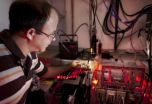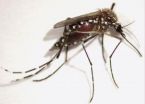(Press-News.org) SANTA CRUZ, CA--A pair of neutron stars spiraling toward each other until they merge in a violent explosion should produce detectable gravitational waves. A new study led by an undergraduate at the University of California, Santa Cruz, predicts for the first time where such mergers are likely to occur in the local galactic neighborhood.
According to Enrico Ramirez-Ruiz, associate professor of astronomy and astrophysics at UC Santa Cruz, the results provide valuable information for researchers at gravitational-wave detectors, such as the Laser Interferometry Gravitational-Wave Observatory (LIGO) in Louisiana and Washington. "This is a very important result, as it is likely to significantly alter how gravitational-wave observatories currently operate," Ramirez-Ruiz said.
Luke Zoltan Kelley, a UCSC undergraduate working with Ramirez-Ruiz, is first author of a paper describing the new findings, to be published in the December 10 issue of Astrophysical Journal Letters and currently available online.
A key prediction of Einstein's general theory of relativity, gravitational waves are ripples in the fabric of space-time caused by the motions of massive objects. Scientists have yet to detect gravitational waves directly because they are so weak and decay rapidly, but a planned upgrade for LIGO (called Advanced LIGO) is expected to greatly increase its sensitivity. Compact binaries--which can consist of two neutron stars, two black holes, or one of each--are among the best candidates for emitting gravitational waves that could be detected by LIGO or other current experiments.
Kelley investigated the implications of a key observation about compact binaries: The two objects are not only moving in orbit around each other, they are also typically speeding through space together, their center of mass moving with a velocity that can be well above 200 kilometers per second.
"By the time the two objects merge, they are likely to be located far away from the galaxy where they were born," Kelley said.
This has implications for efforts to observe mergers that emit gravitational waves. Scientists hope to match a detection at a gravitational-wave observatory with telescope observations of the corresponding merger event. The new study suggests that astronomers might not want to look in the nearest galaxies for these "optical counterparts" of gravitational waves.
"Our predictions show that the proposed use of galaxy catalogs for follow-up from possible gravity-wave detections will need to account for the possibility of mergers away from the observed galaxies," Ramirez-Ruiz said.
The "kick" that sends compact binaries sailing out of their home galaxies comes from a slight asymmetry in the supernova explosions that give birth to neutron stars and black holes. When a massive star explodes, its core collapses to form either a neutron star (a rapidly rotating ball of densely packed neutrons) or a black hole. According to Kelley, a one-percent asymmetry in the supernova explosion would result in a recoil velocity of about 1,000 kilometers per second (about 2 million miles per hour).
"That is around the maximum velocity observed for lone neutron stars and pulsars," he said. "In binary systems, the net kick velocity to the center of mass is noticeably less, and still fairly uncertain, but is around 200 kilometers per second."
The researchers used a standard cosmological simulation of dark matter and the formation of structure in the universe to study how different kick velocities would affect the distribution of merging compact binaries. The simulation, run on a supercomputer at UCSC, showed the formation of halos of dark matter whose gravitational pull is thought to drive the formation of galaxies. The researchers populated the more massive halos with tracer particles representing compact binary systems. On separate runs, they gave the binaries different velocities.
After running the model for a simulated 13.8 billion years (the current age of the universe), Kelley found a region that looked like our local universe, with a galaxy the size of the Milky Way surrounded by a comparable set of neighboring galaxies. He then generated an image of the sky as it would appear to astronomers in the simulated universe, showing the locations of compact binaries and local galaxies.
The results showed that variations in kick velocity lead to marked differences in the distribution of compact binaries. If the merger of a compact binary occurs away from the bright background of a galaxy, it could be detected by a survey telescope such as the planned Large Synoptic Survey Telescope (LSST). The operators of gravitational-wave observatories would then know when and where to look in their data for a gravitational-wave signal, Ramirez-Ruiz said.
He and colleagues at UCSC, including theoretical astrophysicist Stan Woosley and graduate student Luke Roberts, are currently trying to work out what the optical signal of a compact-binary merger should look like. "Detecting the optical counterparts of gravitational-wave detections will be a lot easier if they are not within galaxies," Ramirez-Ruiz said.
###
Kelley is currently finishing up his senior thesis at UCSC, helping Ramirez-Ruiz teach an astrophysics class, and deciding where he will go to graduate school.
In addition to Kelley and Ramirez-Ruiz, the coauthors of the paper include Marcel Zemp of the University of Michigan, Ann Arbor; Jürg Diemand of the Institute for Theoretical Physics at the University of Zurich; and Ilya Mandel of the Kavli Institute at the Massachusetts Institute of Technology. This research was supported by NASA, the David and Lucile Packard Foundation, the U.S. National Science Foundation, and the Swiss National Science Foundation.
END
Menlo Park, Calif. — In a study that could rewrite biology textbooks, scientists have found the first known living organism that incorporates arsenic into the working parts of its cells. What's more, the arsenic replaces phosphorus, an element long thought essential for life. The results, based on experiments at the Stanford Synchrotron Radiation Lightsource, were published online today in Science Express.
"It seems that this particular strain of bacteria has actually evolved in a way that it can use arsenic instead of phosphorus to grow and produce life," said SSRL Staff ...
Will we one day design and create molecules, cells and microorganisms that produce specific chemical products from simple, readily-available, inexpensive starting materials? Will the synthetic organic chemistry now used to produce pharmaceutical drugs, plastics and a host of other products eventually be surpassed by metabolic engineering as the mainstay of our chemical industries? Yes, according to Jay Keasling, chemical engineer and one of the world's foremost practitioners of metabolic engineering.
In a paper published in the journal Science titled "Manufacturing molecules ...
CANCUN/MEXICO, 2 December 2010—Not content to see farming remain outside the international climate change negotiations under way in Mexico, a broad coalition of 17 organizations will bring together more than 400 policy makers, farmers, scientists, business leaders and development specialists on Saturday, December 4 to define steps for opening the door to agriculture within the next six months, permitting its full inclusion in both national action plans as well as the global climate agenda.
"Agriculture is a global crossroads where the issues of climate change, food security ...
WASHINGTON – Moderate consumption of so-called energy drinks can improve people's response time on a lab test measuring behavioral control, but those benefits disappear as people drink more of the beverage, according to a study published by the American Psychological Association.
With the growing popularity of energy drinks such as Red Bull, Monster, Burn and RockStar, especially among high school and college students, psychologists have been studying the effects of sugary, highly caffeinated drinks on young people. College students in particular have been using these ...
BEER-SHEVA, ISRAEL, December 2, 2010 -- Intense, individually tailored dietary treatment for acutely hospitalized elderly has a significant impact on mortality, according to a new study by researchers at Ben-Gurion University of the Negev.
The intervention study just published in the prestigious Journal of the American Geriatric Society showed higher death rates six months after discharge (11.6 percent) of the control group compared to the intervention group's death rate of 3.8 percent, which received intensive nutritional treatment designed and implemented by a registered ...
Rice University researchers have discovered a simple way to make carbon nanotubes shine brighter.
The Rice lab of researcher Bruce Weisman, a pioneer in nanotube spectroscopy, found that adding tiny amounts of ozone to batches of single-walled carbon nanotubes and exposing them to light decorates all the nanotubes with oxygen atoms and systematically changes their near-infrared fluorescence.
Chemical reactions on nanotube surfaces generally kill their limited natural fluorescence, Weisman said. But the new process actually enhances the intensity and shifts the wavelength. ...
LIVERMORE, Calif. - Arsenic - an element that triggers death for most Earthly life forms - is actually allowing for a bacterium to thrive and reproduce.
In a study that may prompt the rewriting of textbooks, a team of astrobiologists and chemists has found the first known living organism that can use arsenic in place of phosphorus in its major macromolecules. The new findings, published in the Dec. 2 Science Express, could redefine origins of life research and alter the way we describe life as we know it.
Oxygen, carbon, hydrogen, nitrogen, sulfur and phosphorous ...
RIVERSIDE, Calif. – Each year, dengue fever infects as many as 100 million people while yellow fever is responsible for about 30,000 deaths worldwide. Both diseases are spread by infected female Aedes aegypti mosquitoes, which require vertebrate blood to produce eggs. The blood feeding and the egg development are tightly linked to how the mosquito transmits the disease-causing virus.
Now a team of entomologists at the University of California, Riverside has identified a microRNA (a short ribonucleic acid molecule) in female Aedes aegypti mosquitoes that when deactivated ...
Raw milk is consumed by an estimated 1-3 percent of the United States population. Raw milk and raw cheeses are responsible for almost 70 percent of reported dairy outbreaks. On July 16, 2008, the Connecticut Department of Public Health identified two unrelated children who had experienced hemolytic uremic syndrome after consuming raw milk from the same farm. The authors investigated the situation further and found more cases of people affected by raw milk from the same farm. The details of their study are chronicled in the Dec. 15 issue of Clinical Infectious Diseases, ...
A fast test to diagnose fatal brain conditions such as mad cow disease in cattle and Creutzfeldt-Jakob disease in humans could be on the horizon, according to a new study from National Institutes of Health scientists. Researchers at NIH's National Institute of Allergy and Infectious Diseases (NIAID) have developed a highly sensitive and rapid new method to detect and measure infectious agents called prions that cause these diseases.
"Although relatively rare in humans and other animals, prion diseases are devastating to those infected and can have huge economic impacts," ...


